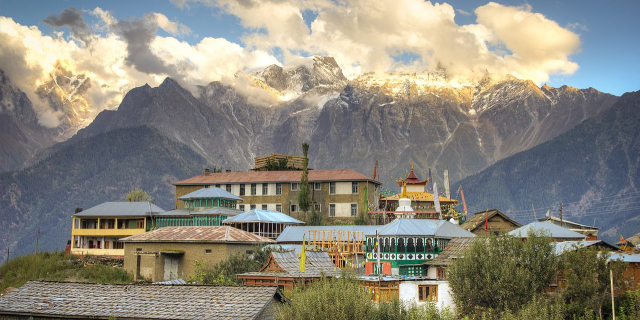The Kalka–Shimla Railway is a 2 ft 6 in (762 mm) narrow-gauge railway in North India which traverses a mostly mountainous route from Kalka to Shimla. It is known for dramatic views of the hills and surrounding villages. The railway was built under the direction of Herbert Septimus Harington between 1898 and 1903 to connect Shimla, the summer capital of India during the British Raj, with the rest of the Indian rail system.
Its early locomotives were manufactured by Sharp, Stewart and Company. Larger locomotives were introduced, which were manufactured by the Hunslet Engine Company. Diesel and diesel-hydraulic locomotives began operation in 1955 and 1970, respectively.
On 8 July 2008, UNESCO added the Kalka–Shimla Railway to the mountain railways of India World Heritage Site.
Shimla (then spelt Simla), which was settled by the British shortly after the first Anglo-Gurkha war, is located at 7,116 feet (2,169 m) in the foothills of the Himalayas. The idea of connecting Shimla by rail was first raised by a correspondent to the Delhi gazette in November 1847.[1][2]
Shimla became the summer capital of British India in 1864, and was the headquarters of the Indian army. This meant that twice a year it was necessary to transfer the entire government between Calcutta and Shimla by horse and ox drawn carts.[1][3]
In 1891 the 5 ft 6 in (1,676 mm) broad gauge Delhi–Kalka line opened, which made the construction of a branch line up to Shimla feasible.[1][4]
The earliest survey was made in 1884 followed by another survey in 1885. Based on these two surveys, a project report was submitted in 1887 to the government of British India.[2] Fresh surveys were made in 1892, and 1893 which lead to four alternative schemes being suggested - two adhesion lines 67.25 mi (108.23 km) and 69.75 mi (112.25 km) long and two rack lines.[2] Fresh surveys were again made in 1895 from Kalka to Solan with a view to determine whether a 1 in 12 rack or 1 in 25 adhesion line should be chosen. After much debate an adhesion line was chosen in preference to a rack system.[2]
Construction of the Kalka–Shimla Railway on 2 ft (610 mm) narrow-gauge tracks was begun by the privately funded Delhi-Ambala-Kalka Railway Company following the signing of a contract between the secretary of state and the company on 29 June 1898.[2][3] The contract specified that the line would be built without any financial aid or guarantee from the government. The government however provided the land free of charge to the company. The estimated cost of 8,678,500 rupees doubled by the time the line was opened.[2] The Chief Engineer of the project was Herbert Septimus Harington.
The 95.68 km (59.45 mi) line opened for traffic on 9 November 1903[3] and was dedicated by Viceroy Lord Curzon.[5] This line was further extended from Shimla to Shimla Goods (which had once housed the bullock cart office) on 27 June 1909 making it 96.60 km (60.02 mi).[6]
The Indian Army were sceptical about the two feet gauge chosen for the line and requested that a wider standard gauge be used for mountain and light strategic railways. Eventually the government agreed that the gauge was too narrow for was essentially a capital city and for military purposes.[1] As a result, the contract with the railway company was revised on 15 November 1901 and the line gauge changed to 2 ft 6 in (762 mm) with the track built to date being regauged.[2][7] Some sources however state the regauging wasn't undertaken until 1905.[8]
In 1905 the company took delivery of a 10-ton Cowans Sheldon travelling crane to assist with lifting rolling stock back onto the tracks after accidents and for general track maintenance.
Due to the high capital and maintenance costs and difficult working conditions, the railway was allowed to charge higher fares than on other lines. Nevertheless, the company had spent 16,525,000 rupees by 1904 with no sign of the line becoming profitable, which lead to it being purchased by the government on 1 January 1906 for 17,107,748 rupees.[2]
Once it came under the control of the government the line was originally managed as an independent unit from the North West Railway office in Lahore until 1926, when it was transferred to Delhi Division. Since July 1987, the line has been managed by the Ambala Division from Ambala Cantt.[6]
In 2007, the Himachal Pradesh government declared the railway a heritage property.[9] For about a week, beginning on 11 September 2007, a UNESCO team visited the railway to inspect it for possible selection as a World Heritage Site. On 8 July 2008, it became part of the mountain railways of India World Heritage Site[10] with the Darjeeling Himalayan and Nilgiri Mountain Railways.[11]
During the 2023 North India floods, several sections of the line were washed out by landslides.[12]

































Add new comment